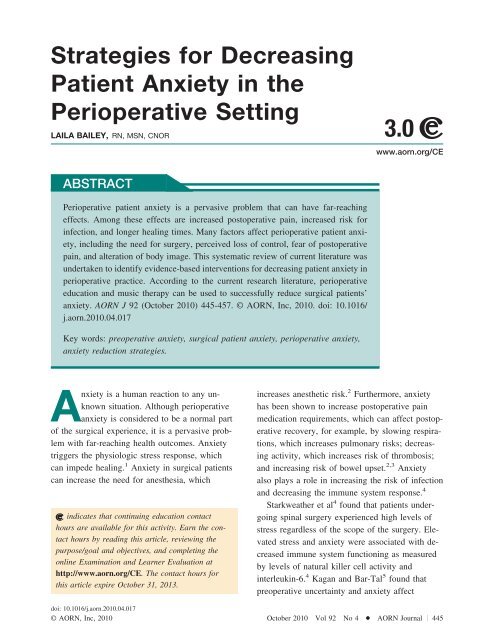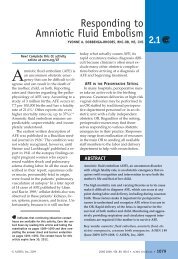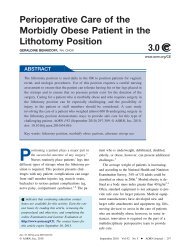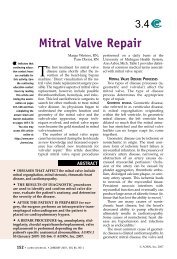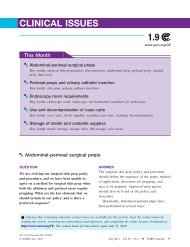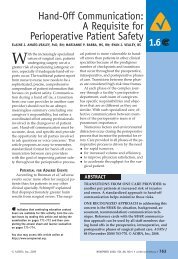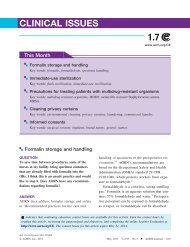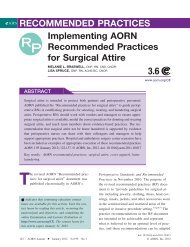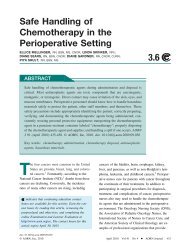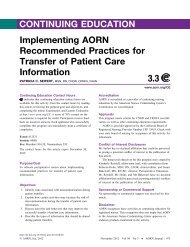Strategies for Decreasing Patient Anxiety in the ... - AORN
Strategies for Decreasing Patient Anxiety in the ... - AORN
Strategies for Decreasing Patient Anxiety in the ... - AORN
You also want an ePaper? Increase the reach of your titles
YUMPU automatically turns print PDFs into web optimized ePapers that Google loves.
<strong>Strategies</strong> <strong>for</strong> <strong>Decreas<strong>in</strong>g</strong><strong>Patient</strong> <strong>Anxiety</strong> <strong>in</strong> <strong>the</strong>Perioperative Sett<strong>in</strong>gLAILA BAILEY, RN, MSN, CNOR3.0www.aorn.org/CEABSTRACTPerioperative patient anxiety is a pervasive problem that can have far-reach<strong>in</strong>geffects. Among <strong>the</strong>se effects are <strong>in</strong>creased postoperative pa<strong>in</strong>, <strong>in</strong>creased risk <strong>for</strong><strong>in</strong>fection, and longer heal<strong>in</strong>g times. Many factors affect perioperative patient anxiety,<strong>in</strong>clud<strong>in</strong>g <strong>the</strong> need <strong>for</strong> surgery, perceived loss of control, fear of postoperativepa<strong>in</strong>, and alteration of body image. This systematic review of current literature wasundertaken to identify evidence-based <strong>in</strong>terventions <strong>for</strong> decreas<strong>in</strong>g patient anxiety <strong>in</strong>perioperative practice. Accord<strong>in</strong>g to <strong>the</strong> current research literature, perioperativeeducation and music <strong>the</strong>rapy can be used to successfully reduce surgical patients’anxiety. <strong>AORN</strong> J 92 (October 2010) 445-457. © <strong>AORN</strong>, Inc, 2010. doi: 10.1016/j.aorn.2010.04.017Key words: preoperative anxiety, surgical patient anxiety, perioperative anxiety,anxiety reduction strategies.<strong>Anxiety</strong> is a human reaction to any unknownsituation. Although perioperativeanxiety is considered to be a normal partof <strong>the</strong> surgical experience, it is a pervasive problemwith far-reach<strong>in</strong>g health outcomes. <strong>Anxiety</strong>triggers <strong>the</strong> physiologic stress response, whichcan impede heal<strong>in</strong>g. 1 <strong>Anxiety</strong> <strong>in</strong> surgical patientscan <strong>in</strong>crease <strong>the</strong> need <strong>for</strong> anes<strong>the</strong>sia, which<strong>in</strong>dicates that cont<strong>in</strong>u<strong>in</strong>g education contacthours are available <strong>for</strong> this activity. Earn <strong>the</strong> contacthours by read<strong>in</strong>g this article, review<strong>in</strong>g <strong>the</strong>purpose/goal and objectives, and complet<strong>in</strong>g <strong>the</strong>onl<strong>in</strong>e Exam<strong>in</strong>ation and Learner Evaluation athttp://www.aorn.org/CE. The contact hours <strong>for</strong>this article expire October 31, 2013.<strong>in</strong>creases anes<strong>the</strong>tic risk. 2 Fur<strong>the</strong>rmore, anxietyhas been shown to <strong>in</strong>crease postoperative pa<strong>in</strong>medication requirements, which can affect postoperativerecovery, <strong>for</strong> example, by slow<strong>in</strong>g respirations,which <strong>in</strong>creases pulmonary risks; decreas<strong>in</strong>gactivity, which <strong>in</strong>creases risk of thrombosis;and <strong>in</strong>creas<strong>in</strong>g risk of bowel upset. 2,3 <strong>Anxiety</strong>also plays a role <strong>in</strong> <strong>in</strong>creas<strong>in</strong>g <strong>the</strong> risk of <strong>in</strong>fectionand decreas<strong>in</strong>g <strong>the</strong> immune system response. 4Starkwea<strong>the</strong>r et al 4 found that patients undergo<strong>in</strong>gsp<strong>in</strong>al surgery experienced high levels ofstress regardless of <strong>the</strong> scope of <strong>the</strong> surgery. Elevatedstress and anxiety were associated with decreasedimmune system function<strong>in</strong>g as measuredby levels of natural killer cell activity and<strong>in</strong>terleuk<strong>in</strong>-6. 4 Kagan and Bar-Tal 5 found thatpreoperative uncerta<strong>in</strong>ty and anxiety affectdoi: 10.1016/j.aorn.2010.04.017© <strong>AORN</strong>, Inc, 2010 October 2010 Vol 92 No 4 ● <strong>AORN</strong> Journal 445
October 2010 Vol 92 No 4 BAILEYwell-be<strong>in</strong>g and short-term recovery. Both variableswere shown to have a negative effect onpostoperative physical symptoms and recovery aswell as overall mental health.Many factors can contribute to a surgical patient’sanxiety level, and <strong>the</strong>se factors can have acumulative effect. Often, surgery is associated withloss of control, fear of postoperative pa<strong>in</strong>, and alteration<strong>in</strong> body image. 1 The need <strong>for</strong> surgery alone<strong>in</strong>creases patient stress and anxiety, no matter <strong>the</strong>extent of <strong>the</strong> planned surgical procedure. 4,6Preoperative wait<strong>in</strong>g was cited <strong>in</strong> several studiesas a trigger <strong>for</strong> anxiety. 1,7,8 In one study, ambulatorysurgery patients felt a sense of abandonmentdur<strong>in</strong>g <strong>the</strong> preoperative period. 7 Long waittimes with little <strong>in</strong><strong>for</strong>mation added to <strong>the</strong>ir anxiety.Some patients reported feel<strong>in</strong>g that nurseswere not open to <strong>the</strong>ir concerns. In addition, <strong>the</strong>sepatients felt that <strong>the</strong>y were not treated as <strong>in</strong>dividualswhile <strong>the</strong>y were wait<strong>in</strong>g <strong>for</strong> surgery. 7Jangland et al 6 found that, among those patientswho compla<strong>in</strong>ed about care and <strong>in</strong>creased anxiety,<strong>the</strong> most common compla<strong>in</strong>ts were <strong>in</strong>sufficient<strong>in</strong><strong>for</strong>mation, <strong>in</strong>adequate respect, and <strong>in</strong>sufficientempathy. These factors <strong>in</strong>creased patient and familymember anxiety and reduced <strong>the</strong>ir confidence<strong>in</strong> <strong>the</strong> health care system.The environment <strong>in</strong>side <strong>the</strong> OR also has aneffect on patient anxiety. Factors such as <strong>the</strong>sound of alarms on mach<strong>in</strong>ery and <strong>the</strong> noise fromsurgical <strong>in</strong>struments be<strong>in</strong>g unpacked can have asignificant effect on <strong>in</strong>creas<strong>in</strong>g anxiety. 8In today’s health care sett<strong>in</strong>g, patients are lesslikely to receive <strong>in</strong>patient care. Often, patients aresent home after procedures that would have requiredan overnight stay just a few years ago. 7Help<strong>in</strong>g patients achieve <strong>the</strong> best outcome is essential<strong>for</strong> <strong>the</strong>ir fast recovery and safe returnhome. Perioperative nurses are pushed to be efficientboth dur<strong>in</strong>g and between procedures, however,which can leave little time to concentrate on<strong>the</strong> psychologic needs of <strong>the</strong> patient. 9Current management of anxiety <strong>in</strong>volves us<strong>in</strong>gmedical <strong>in</strong>terventions, such as adm<strong>in</strong>ister<strong>in</strong>gmidazolam be<strong>for</strong>e surgery, and us<strong>in</strong>g effectivecommunication strategies. 2 Perioperative nurseshave expert knowledge not only of surgical proceduresbut also of <strong>the</strong> surgical environment and <strong>the</strong>experiences patients will face dur<strong>in</strong>g <strong>the</strong>ir time <strong>in</strong><strong>the</strong> perioperative area. This knowledge uniquelypositions perioperative nurses to address patientanxiety with nonmedical <strong>in</strong>terventions. However,given <strong>the</strong> limited time that most perioperativenurses have to spend with <strong>the</strong>ir patients be<strong>for</strong>esurgery, whatever communication and o<strong>the</strong>r nonmedical<strong>in</strong>terventions are used must be preciseand effective. This article reviews current researchto identify effective strategies <strong>for</strong> decreas<strong>in</strong>ganxiety <strong>in</strong> surgical patients and recommendsevidence-based <strong>in</strong>terventions <strong>for</strong> perioperativenurs<strong>in</strong>g practice.REVIEW OF CURRENT RESEARCHI conducted a literature review by us<strong>in</strong>g <strong>the</strong>CINAHL® and ProQuest nurs<strong>in</strong>g databases. Thecomb<strong>in</strong>ation of <strong>the</strong> follow<strong>in</strong>g key words yielded<strong>the</strong> most articles: anxiety, surgery, and <strong>in</strong>tervention.I limited <strong>the</strong> search to research articles publishedfrom 2003 to 2009. This yielded 10 relevantresearch studies (Table 1).Therapeutic RelationshipErci et al 10 studied <strong>the</strong> effect of a <strong>the</strong>rapeutic relationshipon preoperative and postoperative anxiety<strong>in</strong> Turkey. The study sample consisted of 120consecutive patients, 60 assigned to <strong>the</strong> studygroup and 60 to <strong>the</strong> control group. <strong>Patient</strong>s were<strong>in</strong>cluded if <strong>the</strong>y were older than 18 years of age, scheduled <strong>for</strong> a surgical procedure, and capable of giv<strong>in</strong>g voluntary consent.Data were collected by us<strong>in</strong>g <strong>the</strong> Beck <strong>Anxiety</strong>Inventory (BAI). The BAI is designed to assessanxiety <strong>in</strong> cl<strong>in</strong>ical and research sett<strong>in</strong>gs. It is composedof 21 items rated on a 4-po<strong>in</strong>t Likert scale(3 very serious to 0 not serious), with a cumulativescore between zero and 63. The higher <strong>the</strong>score, <strong>the</strong> higher <strong>the</strong> person’s level of anxiety.446 <strong>AORN</strong> Journal
PERIOPERATIVE ANXIETYwww.aornjournal.orgTABLE 1. Summary of Research Articles on Perioperative <strong>Anxiety</strong>StudySample size andcharacteristicsInterventionInstrumentsusedF<strong>in</strong>d<strong>in</strong>gsErci et al 10 N 120Adults scheduled <strong>for</strong>surgery at generalsurgery cl<strong>in</strong>ic <strong>in</strong> Turkey Control group: usual care Study group: <strong>in</strong>terventiondesigned to build a<strong>the</strong>rapeutic relationshipbased on <strong>the</strong>Interpersonal RelationsModel Beck <strong>Anxiety</strong>Inventory (BAI)<strong>Anxiety</strong> mean score (P .001): Pre<strong>in</strong>tervention: Control group 18.2 Study group 18.5 Post<strong>in</strong>tervention: Control group 9.7 Study group 1.4Researchers concluded thatdecreased patient anxiety wasassociated with <strong>the</strong> <strong>in</strong>tervention.Spauld<strong>in</strong>g 3 N 10British patients await<strong>in</strong>gtotal hip replacementprocedure; and N 7education programpresentersQualitative study with<strong>in</strong>terviews with presentersof occupational <strong>the</strong>rapistrunpreoperative educationprogram Control group Intervention group Researcherdesigned cod<strong>in</strong>g of<strong>the</strong>mes fromobservationsIntervention group: <strong>Patient</strong>s stated preoperativeeducation had been helpful <strong>Patient</strong>s suggested that <strong>the</strong>education <strong>in</strong>terventionreduced anxiety <strong>in</strong> <strong>in</strong>terviewswith researchersNg et al 11 N 196<strong>Patient</strong>s undergo<strong>in</strong>goral surgery procedures<strong>in</strong> Hong KongFour patient educationgroups: Group N: basicpreoperative <strong>in</strong><strong>for</strong>mation Group P: basic<strong>in</strong><strong>for</strong>mation with details ofsurgical procedure Group R: basic<strong>in</strong><strong>for</strong>mation with details ofexpected recovery Group PR: basic<strong>in</strong><strong>for</strong>mation with details ofboth surgical procedureand expected recovery Depression <strong>Anxiety</strong>Stress Scale Self report<strong>in</strong>g ofanxiety by patients High trait anxiety patients:mean anxiety scores of R andPR groups significantly lowerthan groups N and P(P .653) Low trait anxiety patients: P, PR, and R groups hadlower anxiety than Ngroup (P .753) PR and R groups hadsignificant changes frombasel<strong>in</strong>e anxiety (P .05)Preoperative <strong>in</strong><strong>for</strong>mationregard<strong>in</strong>g postoperativerecovery and/or surgicalprocedure details led tosignificant reduction of selfreported anxiety.Stirl<strong>in</strong>g et al 2 N 40<strong>Patient</strong>s on a thoracicsurgery ward <strong>in</strong> <strong>the</strong>United K<strong>in</strong>gdomThree groups: Control: rout<strong>in</strong>e care Intervention 1: rout<strong>in</strong>ecare plus use of neutralessential oils Intervention 2: rout<strong>in</strong>ecare plus use of essentialoil blend Strait-Trait <strong>Anxiety</strong>Inventory (STAI)STAI day 21 scores: Control mean 43.13 Neutral oil <strong>in</strong>terventionmean 44.64 Oil blend <strong>in</strong>tervention mean 44.45No statistically significantdifferences<strong>AORN</strong> Journal 447
October 2010 Vol 92 No 4 BAILEYTABLE 1. (cont<strong>in</strong>ued) Summary of Research Articles on Perioperative <strong>Anxiety</strong>StudySample size andcharacteristicsInterventionInstrumentsusedF<strong>in</strong>d<strong>in</strong>gsRoykulcharoen N 102and Good 12 <strong>Patient</strong>s undergo<strong>in</strong>gabdom<strong>in</strong>al surgery (84women; 18 men) <strong>in</strong>ThailandTwo groups: Control group: usual care Intervention group:systemic relaxation Visual AnalogSensation of Pa<strong>in</strong>and Distressscales STAI Control group: Preoperative mean 42.0 End recovery mean 39.7 Intervention group: Preoperative mean 42.5 End recovery mean 38.4No statistically significantdifferenceSeers et al 13 N 118<strong>Patient</strong>s recruited fromgroup admitted <strong>for</strong>total hip or kneereplacement surgery atan orthopaedic hospital<strong>in</strong> <strong>the</strong> United K<strong>in</strong>gdomTwo control groups: one with usual care and one with usual care plusrest<strong>in</strong>g quietly <strong>for</strong> 15m<strong>in</strong>utesTwo <strong>in</strong>tervention groups: one taught jaw relaxationand one taught total bodyrelaxation STAI Visual Analog Pa<strong>in</strong>ScaleMean changes <strong>in</strong> STAI scores(pre<strong>in</strong>tervention andpost<strong>in</strong>tervention): Usual care group:0.115 (standard deviation[SD] 2.160) Usual care plus rest<strong>in</strong>ggroup: 1.179 (SD 2.019) Jaw relaxation group:1.208 (SD 2.502) Total relaxation group:.320 (SD 2.501)There was no statisticallysignificant change <strong>in</strong> scorebetween groups pre<strong>in</strong>terventionto post<strong>in</strong>tervention.Arsian et al 14 N 64Adult men, ages 18 to65 years, undergo<strong>in</strong>gurogenital surgery <strong>in</strong>TurkeyTwo groups: Control group: rout<strong>in</strong>ecare Intervention group:listen<strong>in</strong>g to music <strong>for</strong> 30m<strong>in</strong>utes withheadphones <strong>in</strong> <strong>the</strong>preoperative area STAISTAI mean scores: Be<strong>for</strong>e <strong>the</strong>rapy Control 42.5 Intervention 39.59 After <strong>the</strong>rapy- Control 44.43 Intervention 33.68Control group: <strong>in</strong>creasedanxiety scores (P .003)Intervention group: decreasedanxiety scores (P .000)Cooke et al 15 N 180Adult surgery patients <strong>in</strong>Australia admitted anddischarged <strong>the</strong> sameday as surgery, bothmen and women over<strong>the</strong> age of 18 years, ableto use headphones,fluent <strong>in</strong> English, nopreoperative sedationParticipants randomlyassigned to 1 of 3 groups <strong>in</strong><strong>the</strong> preoperative area: Control: rout<strong>in</strong>e care Placebo: rout<strong>in</strong>e careand headphones <strong>for</strong> 30m<strong>in</strong>utes with no music Intervention: rout<strong>in</strong>e careand music of choice viaheadphones <strong>for</strong> 30m<strong>in</strong>utes STAIPost<strong>in</strong>tervention STAI mean and95% confidence <strong>in</strong>terval (CI): Control: 32.7 (95% CI,31.5-34.0) Placebo: 32.5 (95% CI,31.2-33.8) Intervention: 28.5 (95% CI,27.4-29.6)The music (<strong>in</strong>tervention) grouphad a statistically significantreduction <strong>in</strong> anxiety comparedwith <strong>the</strong> control group (P .001).448 <strong>AORN</strong> Journal
PERIOPERATIVE ANXIETYwww.aornjournal.orgTABLE 1. (cont<strong>in</strong>ued) Summary of Research Articles on Perioperative <strong>Anxiety</strong>StudySample size andcharacteristicsInterventionInstrumentsusedF<strong>in</strong>d<strong>in</strong>gsKa<strong>in</strong> et al 16 N 408Healthy pediatricpatients, ages 2through 10 yearsundergo<strong>in</strong>g generalanes<strong>the</strong>sia <strong>for</strong> electiveoutpatient surgery and<strong>the</strong>ir parents at Yale-New Haven Children’sHospitalFour groups: Control: usual care Group 2: parentalpresence at <strong>in</strong>duction ofanes<strong>the</strong>sia Group 3: midazolam 30m<strong>in</strong>utes be<strong>for</strong>e <strong>in</strong>ductionof anes<strong>the</strong>sia Group 4: <strong>in</strong>tegratedbehavioral preparationprogram <strong>in</strong>clud<strong>in</strong>gparental presence at<strong>in</strong>duction of anes<strong>the</strong>sia Parents: STAI Child: ModifiedYale Preoperative<strong>Anxiety</strong> Scale(mYPAS) Emergencebehavior:observation Analgesicrequirements:code<strong>in</strong>e-unit scaleSignificant differences betweengroups:F 4.2; P .0006Group 4 had significantdecrease <strong>in</strong> anxiety(P .001)MacLaren N 112and Ka<strong>in</strong> 17 Pediatric patients aged2 through 7 yearsundergo<strong>in</strong>g surgery and<strong>the</strong>ir parentsTwo groups: Control: rout<strong>in</strong>e care Intervention: educationprovided to childrenundergo<strong>in</strong>g generalanes<strong>the</strong>sia about mask<strong>in</strong>duction and expectedbehaviors <strong>in</strong> <strong>the</strong> OR;parental <strong>in</strong>struction alsoprovided mYPAS InductionComplianceChecklist <strong>Anxiety</strong>: Change <strong>in</strong> mYPASseparation to <strong>in</strong>ductioncompar<strong>in</strong>g groups – F (1,101) 6.32, P .02 Induction compliance vsnoncompliance (<strong>in</strong>tervention vscontrol) – 2 (1, N 99) 6.14, P .01The <strong>in</strong>tervention group wassignificantly more compliant atanes<strong>the</strong>sia <strong>in</strong>duction than <strong>the</strong>control group.On <strong>the</strong> patient’s first day of enrollment <strong>in</strong> <strong>the</strong>study, <strong>the</strong> patient completed a basel<strong>in</strong>e BAI<strong>in</strong> <strong>the</strong> general surgery cl<strong>in</strong>ic. Immediately afterthis, <strong>the</strong> study group was given an <strong>in</strong>terventionbased on Peplau’s Interpersonal RelationshipModel, which was designed to build a <strong>the</strong>rapeuticrelationship between patient and caregiver, which<strong>in</strong> this study was specifically <strong>the</strong> researcher. TheInterpersonal Relationship Model has four phases(ie, orient<strong>in</strong>g, identification, exploitation, resolution).This researcher used activities of car<strong>in</strong>gwith<strong>in</strong> each of <strong>the</strong> model’s four phases as <strong>the</strong> <strong>in</strong>terventionsof <strong>the</strong> study. The second BAI wascompleted by <strong>the</strong> patient <strong>the</strong> day be<strong>for</strong>e surgery,<strong>the</strong> third was completed <strong>the</strong> day after surgery,and <strong>the</strong> fourth and f<strong>in</strong>al BAI was completed <strong>the</strong>day <strong>the</strong> patient was discharged home. There wasno statistical demographic difference between <strong>the</strong>two groups, and pre<strong>in</strong>tervention anxiety scoresshowed no statistical difference. There was a significantdecrease <strong>in</strong> mean scores <strong>for</strong> patient anxiety<strong>in</strong> <strong>the</strong> study group compared with <strong>the</strong> controlgroup. This change was most pronounced between<strong>the</strong> third and fourth measurements. 10Preoperative In<strong>for</strong>mationTwo studies exam<strong>in</strong>ed <strong>the</strong> effect of preoperative<strong>in</strong><strong>for</strong>mation on reliev<strong>in</strong>g anxiety. 3,11 In Brita<strong>in</strong>,Spauld<strong>in</strong>g 3 looked at <strong>the</strong> effects of a preoperativeeducation program run by occupational <strong>the</strong>rapists<strong>for</strong> patients await<strong>in</strong>g total hip replacement. In thisqualitative, observational study, researchers collecteddata from written patient evaluations, <strong>in</strong>person<strong>in</strong>terviews with patients, <strong>in</strong>terviews with<strong>AORN</strong> Journal 449
October 2010 Vol 92 No 4 BAILEYpresenters of <strong>the</strong> educational programs, and observation.Educational presenters were <strong>in</strong>terviewedtwice, as were patients. The study sample consistedof 10 patients and 7 presenters. <strong>Patient</strong> participantswere selected from <strong>the</strong> list of patients on<strong>the</strong> total hip replacement wait<strong>in</strong>g list and were<strong>in</strong>vited by mail to attend <strong>the</strong> preoperative patientprogram. Accord<strong>in</strong>g to <strong>the</strong> researchers, <strong>the</strong>se subjectivef<strong>in</strong>d<strong>in</strong>gs suggest that preoperative educationreduces anxiety because it gives <strong>the</strong> patient asense of what to expect. 3Ng et al 11 studied <strong>the</strong> effect of preoperative<strong>in</strong><strong>for</strong>mation on <strong>the</strong> anxiety of patients undergo<strong>in</strong>goral surgery <strong>in</strong> Hong Kong. <strong>Patient</strong>s of six dentalpractitioners were recruited <strong>for</strong> <strong>the</strong> study by us<strong>in</strong>gnotices placed <strong>in</strong> <strong>the</strong> dental offices. The 196 patientswho entered <strong>the</strong> study were separated <strong>in</strong>tofour groups: N—received basic <strong>in</strong><strong>for</strong>mation, P—received basic <strong>in</strong><strong>for</strong>mation plus detailsabout <strong>the</strong> surgical procedure, R—received basic <strong>in</strong><strong>for</strong>mation plus details of<strong>the</strong> expected recovery, PR—–received basic <strong>in</strong><strong>for</strong>mation plus detailsof both <strong>the</strong> surgical procedure and expectedrecovery.The Depression <strong>Anxiety</strong> Stress Scale was used tomeasure study participants’ level of trait anxietybe<strong>for</strong>e, dur<strong>in</strong>g, and after surgery. The Depression<strong>Anxiety</strong> Stress Scale is composed of three separatescales (ie, anxiety, depression, stress). Eachscale has 14 items and is answered by <strong>the</strong> participanton a 4-po<strong>in</strong>t Likert scale (0 not applicableto 3 always applicable). The scale was completedbe<strong>for</strong>e <strong>the</strong> patients received any preoperative<strong>in</strong><strong>for</strong>mation. Groups were fur<strong>the</strong>r dividedbased on measurements of high or low trait anxiety.The patients’ self-reported anxiety be<strong>for</strong>e,dur<strong>in</strong>g, and after surgery by rat<strong>in</strong>g <strong>the</strong>ir subjectiveanxiety on a scale of zero to 100 (0 none to100 most <strong>in</strong>tense). The PR and R groups hadstatistically significant decrease <strong>in</strong> anxiety comparedwith <strong>the</strong> basel<strong>in</strong>e measure. The researchersdeterm<strong>in</strong>ed that preoperative education that <strong>in</strong>cluded<strong>in</strong><strong>for</strong>mation about recovery or <strong>in</strong><strong>for</strong>mationabout recovery and <strong>the</strong> <strong>in</strong>traoperative and postoperativeperiods helped decrease <strong>the</strong> anxiety ofstudy participants. However, receiv<strong>in</strong>g only basic<strong>in</strong><strong>for</strong>mation about <strong>the</strong> procedure (ie, <strong>the</strong> N group)only decreased anxiety <strong>in</strong> those participants whohad a lower level of anxiety be<strong>for</strong>e <strong>the</strong> surgicalexperience. 11Essential OilsThe effect of essential oils <strong>in</strong> reduc<strong>in</strong>g perioperativepatient anxiety was studied by Stirl<strong>in</strong>g et al. 2This was a double-bl<strong>in</strong>d randomized study to determ<strong>in</strong>e<strong>the</strong> feasibility <strong>for</strong> a larger study to exam<strong>in</strong>e<strong>the</strong> effects of essential oils on <strong>the</strong> anxiety ofpatients await<strong>in</strong>g surgery <strong>in</strong> a thoracic ward. Participantswere randomly assigned to ei<strong>the</strong>r <strong>the</strong>control or study group. Although <strong>the</strong> goal was tohave 30 participants <strong>in</strong> each group and 71 patientsconsented to participate, only 40 completed <strong>the</strong>study.Participants were given essential oils to selfapplyand to take home to cont<strong>in</strong>ue use <strong>for</strong> 21days after discharge. Participants were <strong>in</strong>structedto use <strong>the</strong> oil cont<strong>in</strong>uously from postoperative day1 through day 21. Participants completed <strong>the</strong>State-Trait <strong>Anxiety</strong> Inventory (STAI), which consistsof 20 statements rated us<strong>in</strong>g 4-po<strong>in</strong>t Likertscale, to <strong>in</strong>dicate how <strong>the</strong>y felt at a particulartime. Higher scores <strong>in</strong>dicate higher anxiety. Datawere collected be<strong>for</strong>e <strong>the</strong> <strong>in</strong>tervention and at day3 and day 21 of <strong>the</strong> study. Results were reportedas differences <strong>in</strong> STAI measurements on day 3and day 21 <strong>for</strong> each participant.Low patient participation made it difficult <strong>for</strong><strong>the</strong> researchers to draw specific conclusions from<strong>the</strong> results. In addition, <strong>the</strong> study had less powerto detect differences <strong>in</strong> anxiety because <strong>the</strong> patientpopulation did not have uni<strong>for</strong>m pre<strong>in</strong>terventionanxiety. This study did not demonstratea statistically significant relationship between <strong>the</strong>use of essential oils and anxiety reduction. It is450 <strong>AORN</strong> Journal
PERIOPERATIVE ANXIETYwww.aornjournal.orgdifficult to draw specific conclusions about <strong>the</strong><strong>in</strong>tervention because of <strong>the</strong> study’s limitations. 2Relaxation TechniquesTwo studies exam<strong>in</strong>ed <strong>the</strong> use of relaxation techniques<strong>in</strong> surgical patients. 12,13 Roykulcharoenand Good 12 exam<strong>in</strong>ed <strong>the</strong> effect of systematicrelaxation on pa<strong>in</strong> and anxiety dur<strong>in</strong>g recoveryafter abdom<strong>in</strong>al surgery. Their work was based onOrem’s Self-Care Theory and <strong>the</strong> <strong>the</strong>oretical assumptionthat nurses assist patients <strong>in</strong> meet<strong>in</strong>g <strong>the</strong>need to care <strong>for</strong> <strong>the</strong>mselves. This study was undertakenat a large hospital <strong>in</strong> Thailand. <strong>Patient</strong>sundergo<strong>in</strong>g surgery were eligible to participate if<strong>the</strong>y were 20 to 65 years of age, were expect<strong>in</strong>g to rema<strong>in</strong> <strong>in</strong> <strong>the</strong> hospital twoto three days after surgery, and would receive opioid pa<strong>in</strong> medication asneeded.Participants were randomly assigned to <strong>the</strong> experimentalor control group. Participants <strong>in</strong> <strong>the</strong>experimental group were taught systematic relaxationbe<strong>for</strong>e surgery. The Visual Analog Sensationof Pa<strong>in</strong> and Distress scale was used to measurepa<strong>in</strong> <strong>in</strong> <strong>the</strong> area of <strong>the</strong> patient’s <strong>in</strong>cision. TheVisual Analog Sensation of Pa<strong>in</strong> and Distressscale is a dual scale; <strong>the</strong> pa<strong>in</strong> scale is a 100-mmhorizontal l<strong>in</strong>e, with ends marked zero (ie, nosense of pa<strong>in</strong>) and 100 (ie, <strong>the</strong> worst imag<strong>in</strong>ablepa<strong>in</strong>), and <strong>the</strong> distress scale is a 100-mm horizontall<strong>in</strong>e with ends marked zero (ie, no distress)and 100 (ie, most distress imag<strong>in</strong>able). Pa<strong>in</strong> wasmeasured immediately after patients returned tobed after ambulation and <strong>the</strong>n 15 m<strong>in</strong>utes afterrelaxation techniques were used. The distressscale was used to <strong>in</strong>dicate <strong>the</strong> amount of emotionalupset associated with <strong>the</strong> pa<strong>in</strong>. Participants’opioid use was also measured. The researchersreported that patients <strong>in</strong> <strong>the</strong> experimental grouphad significantly less distress and decreased sensationsof pa<strong>in</strong> than patients <strong>in</strong> <strong>the</strong> control group;however, <strong>the</strong> <strong>in</strong>tervention did not affect postoperativeanxiety or opioid <strong>in</strong>take. 12In a separate study, Seers et al 13 studied postoperativepa<strong>in</strong> and anxiety, and <strong>the</strong> effects of relaxation.They exam<strong>in</strong>ed jaw relaxation techniquesas well as total body relaxation techniqueswith patients admitted <strong>for</strong> total hip or knee replacement<strong>in</strong> an orthopaedic hospital <strong>in</strong> <strong>the</strong>United K<strong>in</strong>gdom. The goal was to enlist 236 patients,but only 200 were recruited, and only 118completed <strong>the</strong> study. There were two relaxation<strong>in</strong>tervention groups and two control groups. Thefirst experimental group was taught total bodyrelaxation, and <strong>the</strong> second experimental groupwas taught jaw relaxation. The first control groupreceived <strong>the</strong> usual care, and <strong>the</strong> second controlgroup received <strong>the</strong> usual care and also rested quietlyon <strong>the</strong>ir own <strong>for</strong> 15 to 20 m<strong>in</strong>utes. Pa<strong>in</strong> andanxiety scores were measured be<strong>for</strong>e surgery andafter <strong>the</strong> <strong>in</strong>tervention by us<strong>in</strong>g <strong>the</strong> STAI. Although<strong>the</strong>re were changes <strong>in</strong> pa<strong>in</strong> scores, no significantdifference was found <strong>in</strong> anxiety scoresbetween any of <strong>the</strong> groups. In addition, <strong>the</strong> researchersreport that <strong>the</strong> effect of total body relaxationwas not long-last<strong>in</strong>g. 13Music TherapyTwo articles described <strong>the</strong> effects of music onstress and anxiety <strong>in</strong> surgical patients. 14,15 Arsianet al 14 <strong>in</strong>vestigated <strong>the</strong> effect of music on preoperativeanxiety. The sample was composed ofmen who were to undergo urogenital surgery <strong>in</strong>Turkey. <strong>Patient</strong>s were recruited from an <strong>in</strong>patient urology cl<strong>in</strong>ic, between <strong>the</strong> ages of 18 and 65 years, and fluent <strong>in</strong> Turkish.After enroll<strong>in</strong>g <strong>in</strong> <strong>the</strong> study, 32 participants wereassigned to <strong>the</strong> control group and 32 participantswere assigned to <strong>the</strong> experimental group. On <strong>the</strong>day of surgery, participants <strong>in</strong> both <strong>the</strong> controland experimental groups completed <strong>the</strong> STAI.The participants <strong>in</strong> <strong>the</strong> experimental group were<strong>the</strong>n asked to pick <strong>the</strong>ir favorite selection from avariety of music. They were given a portable cassetteplayer with <strong>the</strong>ir choice of music and headphones,and <strong>the</strong>y listened to <strong>the</strong> music <strong>for</strong> 30<strong>AORN</strong> Journal 451
PERIOPERATIVE ANXIETYwww.aornjournal.orgParental anxiety was measured by us<strong>in</strong>g <strong>the</strong>STAI; child anxiety was measured on <strong>the</strong> modifiedYale Preoperative <strong>Anxiety</strong> Scale (mYPAS).The mYPAS consists of 27 items <strong>in</strong> five categories,and data are ga<strong>the</strong>red via observation to assess<strong>the</strong> anxiety behavior of children <strong>in</strong> <strong>the</strong> perioperativesett<strong>in</strong>g. Emergence behavior was ratedon a 3-po<strong>in</strong>t scale by tra<strong>in</strong>ed observers, analgesiarequirements were measured from <strong>the</strong> patient’smedical record and converted to a code<strong>in</strong>e-unitscale, and time <strong>the</strong> patient arrived <strong>in</strong> <strong>the</strong> postanes<strong>the</strong>siacare unit was used <strong>for</strong> <strong>the</strong> dischargetime. There were 408 participants <strong>in</strong> <strong>the</strong> study,and all of <strong>the</strong> four groups were similar <strong>in</strong> demographiccharacteristics. Us<strong>in</strong>g two-way ANOVA,researchers determ<strong>in</strong>ed that <strong>the</strong>re was significantlylower anxiety <strong>in</strong> <strong>the</strong> children <strong>in</strong> <strong>the</strong> ADVANCEgroup compared with children <strong>in</strong> <strong>the</strong> o<strong>the</strong>r threegroups (P .001). In addition, children <strong>in</strong> <strong>the</strong>ADVANCE group were less likely to exhibit emergence delirium, received only half as much fentanyl comparedwith <strong>the</strong> parental-presence group and onlyone-third as much fentanyl as <strong>the</strong> o<strong>the</strong>r twogroups, and were discharged significantly earlier than children<strong>in</strong> <strong>the</strong> o<strong>the</strong>r three groups. 16MacLaren and Ka<strong>in</strong> 17 exam<strong>in</strong>ed an educationalprogram <strong>for</strong> pediatric patients concern<strong>in</strong>g anes<strong>the</strong>sia<strong>in</strong>duction and what to expect of <strong>the</strong> anes<strong>the</strong>ticexperience. The researchers randomly assigned112 children, rang<strong>in</strong>g from two to seven years ofage, to ei<strong>the</strong>r <strong>the</strong> control or <strong>the</strong> <strong>in</strong>terventiongroup. Measures were made with <strong>the</strong> mYPAS, <strong>the</strong>STAI, and <strong>the</strong> Induction Compliance Checklist.The Induction Compliance Checklist is an 11-itemscale used to analyze a child’s behavior dur<strong>in</strong>g<strong>in</strong>duction of anes<strong>the</strong>sia. Each item represents abehavior that <strong>in</strong>terferes with mask <strong>in</strong>duction (eg,turn<strong>in</strong>g <strong>the</strong> head away from <strong>the</strong> mask) and israted zero (ie, present) or 1 (ie, absent). The InductionCompliance Checklist was used <strong>in</strong> thisstudy to measure <strong>the</strong> behavior of <strong>the</strong> participantsat <strong>the</strong> time of anes<strong>the</strong>sia <strong>in</strong>duction as rated by <strong>the</strong>research observer.After patients and <strong>the</strong>ir family members hadarrived <strong>in</strong> <strong>the</strong> preoperative hold<strong>in</strong>g area, <strong>the</strong> parentswere given <strong>the</strong> STAI, while <strong>the</strong> childrenwere observed by tra<strong>in</strong>ed research assistants whofilled out <strong>the</strong> mYPAS. After this basel<strong>in</strong>e observation,children were randomly assigned to one of<strong>the</strong> two groups. Children <strong>in</strong> <strong>the</strong> <strong>in</strong>tervention groupwere <strong>the</strong>n exposed to <strong>the</strong> shap<strong>in</strong>g <strong>in</strong>tervention,which <strong>in</strong>cluded be<strong>in</strong>g <strong>in</strong>troduced to <strong>the</strong> anes<strong>the</strong>siamask and to <strong>the</strong> desired behaviors expected when<strong>the</strong>y enter <strong>the</strong> OR. Examples of desired behavior<strong>in</strong>cluded <strong>the</strong> child play<strong>in</strong>g with an anes<strong>the</strong>sia facemask, <strong>the</strong> child putt<strong>in</strong>g <strong>the</strong> mask over his or hermouth, <strong>the</strong> child allow<strong>in</strong>g <strong>the</strong> parents to hold <strong>the</strong>mask on <strong>the</strong> child’s face, and <strong>the</strong> child climb<strong>in</strong>gonto <strong>the</strong> exam<strong>in</strong>ation table.Parents of children <strong>in</strong> <strong>the</strong> <strong>in</strong>tervention groupalso were given <strong>in</strong>structions about <strong>the</strong> <strong>in</strong>ductionof anes<strong>the</strong>sia. The children <strong>in</strong> both groups wererated on <strong>the</strong> mYPAS when called to <strong>the</strong> OR andat <strong>in</strong>duction of anes<strong>the</strong>sia. Multivariate analysiswas used to evaluate <strong>the</strong> f<strong>in</strong>d<strong>in</strong>gs. This analysisfound that <strong>the</strong>re were significant differences betweengroups (P .02). In addition, <strong>the</strong>re was arelationship between group and time. <strong>Anxiety</strong> <strong>in</strong>creasedsignificantly from <strong>the</strong> basel<strong>in</strong>e measurementto when <strong>the</strong> measurement was taken at <strong>the</strong>po<strong>in</strong>t of separation from <strong>the</strong> parents <strong>for</strong> <strong>the</strong> <strong>in</strong>terventiongroup compared with <strong>the</strong> control group.However, <strong>the</strong>re was a significant <strong>in</strong>crease <strong>in</strong> anxiety<strong>for</strong> <strong>the</strong> control group from separation fromparents to <strong>in</strong>duction of anes<strong>the</strong>sia, whereas <strong>the</strong><strong>in</strong>tervention group had a statistically significantdecrease <strong>in</strong> this score. In addition, children <strong>in</strong> <strong>the</strong><strong>in</strong>tervention group were significantly more likelyto be compliant at <strong>in</strong>duction than children <strong>in</strong> <strong>the</strong>control group (P .01). Parents’ anxiety wasmeasured <strong>in</strong> <strong>the</strong> preoperative hold<strong>in</strong>g area andaga<strong>in</strong> at separation from <strong>the</strong>ir child. Parents’ anxiety<strong>in</strong>creased regardless of group assignment. Theresearchers concluded that children <strong>in</strong> <strong>the</strong> <strong>in</strong>terventiongroup were significantly more compliant<strong>AORN</strong> Journal 453
October 2010 Vol 92 No 4 BAILEYat <strong>in</strong>duction of anes<strong>the</strong>sia and had smaller <strong>in</strong>creasesof anxiety from basel<strong>in</strong>e than did children<strong>in</strong> <strong>the</strong> control group, but <strong>the</strong> <strong>in</strong>tervention did notaffect <strong>the</strong> anxiety scores of <strong>the</strong> parents. 17IMPLICATIONS FOR PRACTICEAs this literature review demonstrates, many strategies<strong>for</strong> reduc<strong>in</strong>g patient anxiety have been tried,but only a few have proven successful. The mosteffective <strong>in</strong>terventions from <strong>the</strong> current literatureare perioperative patient education and music<strong>the</strong>rapy. A care plan that identifies nurs<strong>in</strong>g actionsto manage <strong>the</strong> perioperative anxiety of any patientundergo<strong>in</strong>g a surgical procedure is presented <strong>in</strong>Table 2.Preoperative EducationIn today’s health care system, it is rare <strong>for</strong> patientsundergo<strong>in</strong>g scheduled surgery to be admittedbe<strong>for</strong>e <strong>the</strong> morn<strong>in</strong>g of <strong>the</strong>ir procedure. Thisadmission rout<strong>in</strong>e limits <strong>the</strong> time that nurses haveto implement a preoperative education plan. Inaddition, nurses <strong>in</strong> <strong>the</strong> preoperative and <strong>in</strong>traoperativeareas are pushed to move patients throughquickly. These factors can limit <strong>the</strong> amount oftime that can be dedicated to a preoperative educationprogram.From <strong>the</strong> review of current evidence, it is clearthat some <strong>for</strong>m of basic education should be implemented<strong>for</strong> patients on <strong>the</strong> day of surgery. Becausesome <strong>in</strong>dividuals do not want as much <strong>in</strong><strong>for</strong>mationas o<strong>the</strong>rs, a framework of general<strong>in</strong><strong>for</strong>mation can be put <strong>in</strong> place <strong>for</strong> all patients.Opportunities should be provided <strong>for</strong> patients toask questions if more <strong>in</strong><strong>for</strong>mation is sought. Thisbasic educational material should <strong>in</strong>clude an overviewof <strong>the</strong> surgical process. I suggest <strong>the</strong> <strong>in</strong><strong>for</strong>mationshould <strong>in</strong>clude what to expect <strong>in</strong> <strong>the</strong> preoperativearea, emphasiz<strong>in</strong>gthat wait times can vary,who to ask <strong>for</strong> <strong>in</strong><strong>for</strong>mation should a questionarise,who <strong>the</strong>y will meet dur<strong>in</strong>g this time, and<strong>the</strong> general process of gett<strong>in</strong>g ready <strong>for</strong>surgery.<strong>Patient</strong>s also should be given general <strong>in</strong>traoperative<strong>in</strong><strong>for</strong>mation, <strong>in</strong>clud<strong>in</strong>g that <strong>the</strong>y will move to ano<strong>the</strong>r bed after arriv<strong>in</strong>g <strong>in</strong><strong>the</strong> OR, <strong>the</strong>re will be unusual equipment around, people may be com<strong>in</strong>g and go<strong>in</strong>g, and that it can be cold, but warm blankets are alwaysavailable.Postoperative In<strong>for</strong>mationPostoperative <strong>in</strong><strong>for</strong>mation that patients need <strong>in</strong>cludesreassurance that pa<strong>in</strong> needs will be met, anexplanation of how <strong>the</strong> pa<strong>in</strong> scale will work tohelp <strong>the</strong>m communicate <strong>the</strong>ir needs, and whatto expect on discharge. Although not all healthcare providers will be able to give <strong>the</strong> postoperative<strong>in</strong><strong>for</strong>mation specific to each surgery andsurgeon, a general overview of <strong>the</strong> postoperativeand discharge process should be <strong>in</strong>cluded<strong>in</strong> any teach<strong>in</strong>g plan. For families with pediatricpatients, research results show that educationbe<strong>for</strong>e <strong>the</strong> day of surgery is helpful. 17 Ifthat is not possible, <strong>the</strong>n basic <strong>in</strong><strong>for</strong>mationabout <strong>in</strong>duction of anes<strong>the</strong>sia should be <strong>in</strong>cludedwith o<strong>the</strong>r basic preoperative teach<strong>in</strong>g tohelp decrease fears and <strong>in</strong>crease understand<strong>in</strong>gby patients and <strong>the</strong>ir parents. 16Music TherapyMusic <strong>the</strong>rapy is an <strong>in</strong>tervention that has alsoshown effectiveness <strong>in</strong> reduc<strong>in</strong>g preoperativeanxiety. However, giv<strong>in</strong>g each patient his orher own music player <strong>for</strong> use on <strong>the</strong> day of surgerymay not be feasible <strong>in</strong> all sett<strong>in</strong>gs, especiallygiven current constra<strong>in</strong>ts on health careorganization budgets. O<strong>the</strong>r, more cost-effectiveways of provid<strong>in</strong>g calm<strong>in</strong>g music <strong>in</strong> <strong>the</strong> preoperativeand <strong>in</strong>traoperative environments shouldbe evaluated by facilities as a way of reduc<strong>in</strong>ganxiety <strong>for</strong> patients.454 <strong>AORN</strong> Journal
PERIOPERATIVE ANXIETYwww.aornjournal.orgTABLE 2. Care Plan <strong>for</strong> Manag<strong>in</strong>g Perioperative <strong>Patient</strong> <strong>Anxiety</strong>DiagnosisNurs<strong>in</strong>g <strong>in</strong>terventionsInterim outcomestatementOutcomestatement<strong>Anxiety</strong>or <strong>in</strong>effectivecop<strong>in</strong>g Identifies psychosocial status.Evaluates psychosocial status relative to age andstage of development.Identifies patient home profile (eg, householdcomposition, ages, gender, roles, occupations; familycop<strong>in</strong>g skills, limitations). Identifies patient’s resources (eg, <strong>in</strong>surance, homeenvironment, extended family, community). Assesses cop<strong>in</strong>g mechanisms. Reviews patient’s cop<strong>in</strong>g pattern and itseffectiveness. Identifies patient’s religious practices. Identifies philosophical, cultural, and spiritual beliefsand related practices. Asks <strong>the</strong> patient to describe current methods ofdeal<strong>in</strong>g with stress. Observes <strong>for</strong> behavior that may <strong>in</strong>dicate <strong>in</strong>effectivecop<strong>in</strong>g (eg, verbalization of anger, depression,<strong>in</strong>effective cop<strong>in</strong>g, alterations <strong>in</strong> diet, disruption ofsleep pattern; restlessness; absence of eye contact;absence of or reduced participation <strong>in</strong> plan of care;withdrawal from family or staff members; hostilitytoward family or staff members). Determ<strong>in</strong>es when <strong>the</strong>se behaviors became firstapparent. Encourages patient to express feel<strong>in</strong>gs. Determ<strong>in</strong>es <strong>the</strong> most effective methods ofcommunication and support. Evaluates availability and effectiveness of supportsystem. Identifies patient and designated support person’seducational needs. Determ<strong>in</strong>es knowledge level. Elicits perceptions of surgery. Identifies barriers to communication. Determ<strong>in</strong>es <strong>the</strong> patient’s ability to understand <strong>the</strong><strong>in</strong><strong>for</strong>mation offered. Includes <strong>the</strong> patient or designated support person <strong>in</strong>perioperative teach<strong>in</strong>g. Expla<strong>in</strong>s expected sequence of events. Provides status reports to <strong>the</strong> designated support person. Implements measures to provide psychologic support. Assesses <strong>for</strong> signs and symptoms of anxiety or fear(eg, fears and concerns, preoperative <strong>in</strong>somnia,muscle tenseness, tremors, irritability, change <strong>in</strong>appetite, restlessness, diaphoresis, tachypnea,tachycardia, elevated blood pressure, facial pallor orflush<strong>in</strong>g, withdrawn behavior). The patientverbalizes <strong>the</strong>sequence of eventsto expect be<strong>for</strong>e andimmediately aftersurgery. The patient statesrealistic expectationsregard<strong>in</strong>g recoveryfrom <strong>the</strong> procedure. The patient andfamily describe <strong>the</strong>prescribedpostoperativeregimen accurately. The patient ordesignated supportperson demonstratesknowledge of <strong>the</strong>expected responsesto <strong>the</strong> operative or<strong>in</strong>vasive procedure.<strong>AORN</strong> Journal 455
October 2010 Vol 92 No 4 BAILEYTABLE 2. (cont<strong>in</strong>ued) Care Plan <strong>for</strong> Manag<strong>in</strong>g Perioperative <strong>Patient</strong> <strong>Anxiety</strong>DiagnosisNurs<strong>in</strong>g <strong>in</strong>terventionsInterim outcomestatementOutcomestatement Orients patient to environment and care rout<strong>in</strong>es andpractices. Introduces staff members. Assures <strong>the</strong> patient that a member of <strong>the</strong> staff isnearby. Provides <strong>in</strong><strong>for</strong>mation and answers questions honestly. Ma<strong>in</strong>ta<strong>in</strong>s a calm, supportive, confident manner. Provides an atmosphere of care and concern (eg,privacy, nonjudgmental approach, empathy, respect). Offers alternative methods to m<strong>in</strong>imize anxiety (eg,music, humor). Re<strong>in</strong><strong>for</strong>ces physician’s explanations and clarifiesmisconceptions. Expla<strong>in</strong>s <strong>the</strong> purpose of preoperative preparationsbe<strong>for</strong>e implementation. Encourages patient participation <strong>in</strong> decision mak<strong>in</strong>gand plann<strong>in</strong>g <strong>for</strong> postoperative care. Evaluates psychosocial response to <strong>the</strong> plan of care.FURTHER RESEARCHThe evidence presented here supports implementationof perioperative education and music <strong>the</strong>rapyto decrease patient anxiety. Manag<strong>in</strong>g <strong>the</strong>environment also could help decrease <strong>the</strong> effect of<strong>the</strong> perioperative environment on patients’ anxiety.When a patient enters <strong>the</strong> OR, care should betaken to silence mach<strong>in</strong>ery, so that unnecessaryalarms do not startle or frighten <strong>the</strong> patient. Inaddition, unpack<strong>in</strong>g and mov<strong>in</strong>g <strong>in</strong>struments andequipment should be m<strong>in</strong>imized. Implement<strong>in</strong>g asystem to keep patients and <strong>the</strong>ir family membersupdated while <strong>the</strong>y are wait<strong>in</strong>g <strong>for</strong> <strong>the</strong>ir procedurescould help decrease anxiety and reassure patientsthat all is well. Reliable, replicable programs <strong>in</strong><strong>the</strong>se areas should be developed and tested to determ<strong>in</strong>e<strong>the</strong> optimal <strong>in</strong>terventions to reduce perioperativeanxiety <strong>for</strong> patients and families.Although articles about anxiety and surgeryare available <strong>in</strong> <strong>the</strong> current literature, more studiesneed to be per<strong>for</strong>med to develop and test<strong>in</strong>terventions to determ<strong>in</strong>e <strong>the</strong>ir effectiveness <strong>in</strong>reduc<strong>in</strong>g anxiety <strong>in</strong> <strong>the</strong> fast-paced perioperativearea. Because of <strong>the</strong> paucity of research be<strong>in</strong>gper<strong>for</strong>med on this topic <strong>in</strong> <strong>the</strong> United States,many of <strong>the</strong> studies reviewed here <strong>for</strong> evidencehave come from o<strong>the</strong>r cultures and discipl<strong>in</strong>es.Although it can be difficult to extrapolate andapply data from research done <strong>in</strong> diverse cultures,<strong>the</strong>se studies can po<strong>in</strong>t <strong>the</strong> way <strong>for</strong> fur<strong>the</strong>rresearch opportunities. <strong>Anxiety</strong> can have farreach<strong>in</strong>geffects on surgical outcomes. Develop<strong>in</strong>geffective anxiety-reduc<strong>in</strong>g strategies based on evidenceis essential to optimize patient care.Editor’s note: CINAHL, Cumulative Index toNurs<strong>in</strong>g and Allied Health Literature, is a registeredtrademark of EBSCO Industries, Birm<strong>in</strong>gham,AL.References1. Grieve RJ. Day surgery preoperative anxiety reductionand cop<strong>in</strong>g strategies. Br J Nurs. 2002;11(10):670-678.2. Stirl<strong>in</strong>g L, Raab G, Alder EM, Robertson F. Randomizedtrial of essential oils to reduce perioperative patientanxiety: feasibility study. J Adv Nurs. 2007;60(5):494-501.456 <strong>AORN</strong> Journal
PERIOPERATIVE ANXIETYwww.aornjournal.org3. Spauld<strong>in</strong>g NJ. Reduc<strong>in</strong>g anxiety by pre-operative education:make <strong>the</strong> future familiar. Occup Ther Int. 2003;10(4):278-293.4. Starkwea<strong>the</strong>r AR, Witek-Janusek L, Nockels RP, PetersonJ, Ma<strong>the</strong>ws HL. Immune function, pa<strong>in</strong>, and psychologicalstress <strong>in</strong> patients undergo<strong>in</strong>g sp<strong>in</strong>al surgery.Sp<strong>in</strong>e. 2006;31(18):E641-E647.5. Kagan I, Bar-Tal Y. The effects of preoperative uncerta<strong>in</strong>tyand anxiety on short-term recovery after electivearthroplasty. J Cl<strong>in</strong> Nurs.2008;17(5):576-583.6. Jangland E, Gunn<strong>in</strong>gberg L, Carsson M. <strong>Patient</strong>s’ andrelatives’ compla<strong>in</strong>ts about encounters and communication<strong>in</strong> health care: evidence <strong>for</strong> quality improvement.<strong>Patient</strong> Educ Couns. 2009;75(2):199-204.7. Gilmart<strong>in</strong> J, Wright K. Day surgery: patients’ felt abandoneddur<strong>in</strong>g <strong>the</strong> preoperative wait. J Cl<strong>in</strong> Nurs. 2008;17(18):2418-2425.8. Haugen AS, Eide GE, Olsen MV, Haukeland B,Remme AR, Wahl AK. <strong>Anxiety</strong> <strong>in</strong> <strong>the</strong> operat<strong>in</strong>g <strong>the</strong>atre:a study of frequency and environmental impact <strong>in</strong>patients hav<strong>in</strong>g local, plexus or regional anes<strong>the</strong>sia.J Cl<strong>in</strong> Nurs. 2009;18(16):2301-2310.9. Stirl<strong>in</strong>g L. Reduction and management of perioperativeanxiety. Br J Nurs.2006;15(7):359-361.10. Erci B, Sezg<strong>in</strong> S, Kacmaz Z. The impact of <strong>the</strong>rapeuticrelationship on preoperative and postoperative patientanxiety. Aust J Adv Nurs. 2008;26(1):59-66.11. Ng SKS, Chau AWL, Leung WK. The effect of preoperative<strong>in</strong><strong>for</strong>mation <strong>in</strong> reliev<strong>in</strong>g anxiety <strong>in</strong> oral surgerypatients. Community Dent Oral Epidemiol. 2004;32(3):227-235.12. Roykulcharoen V, Good M. Systematic relaxation to relievepostoperative pa<strong>in</strong>. J Adv Nurs. 2004;48(2):140-148.13. Seers K, Crichton N, Tutton L, Smith L, Saunders T.Effectiveness of relaxation <strong>for</strong> postoperative pa<strong>in</strong> andanxiety: randomized controlled trial. J Adv Nurs. 2008;62(6):681-688.14. Arsian S, Ozer N, Ozyurt F. Effect of music on preoperativeanxiety <strong>in</strong> men undergo<strong>in</strong>g urogenital surgery.Aust J Adv Nurs. 2008;26(2):46-54.15. Cooke M, Chaboyer W, Schluter P, Hiratos M. Theeffect of music on preoperative anxiety <strong>in</strong> day surgery.J Adv Nurs. 2005;52(1):47-55.16. Ka<strong>in</strong> ZN, Caldwell-Andrews AA, Mayes LC, et al.Family-centered preparation <strong>for</strong> surgery improves perioperativeoutcomes <strong>in</strong> children: a randomized controlledstudy. Anes<strong>the</strong>siology. 2007;106(1):65-74.17. MacLaren JE, Ka<strong>in</strong> ZN. Development of a brief behavioral<strong>in</strong>tervention <strong>for</strong> children’s anxiety at anes<strong>the</strong>sia<strong>in</strong>duction. Child Health Care. 2008;37(3):196-209.Laila Bailey, RN, MSN, CNOR, is a staffnurse and urology/cystoscopy specialist atInova Fairfax Hospital Ambulatory SurgeryCenter, Fairfax, VA. Ms Bailey has no declaredaffiliation that could be perceived aspos<strong>in</strong>g a potential conflict of <strong>in</strong>terest <strong>in</strong> <strong>the</strong>publication of this article.<strong>AORN</strong> Journal 457
EXAMINATIONCONTINUING EDUCATION PROGRAM<strong>Strategies</strong> <strong>for</strong> <strong>Decreas<strong>in</strong>g</strong> <strong>Patient</strong><strong>Anxiety</strong> <strong>in</strong> <strong>the</strong> Perioperative Sett<strong>in</strong>g3.0www.aorn.org/CEPURPOSE/GOALTo educate perioperative nurses about methods to decrease patient anxiety <strong>in</strong> <strong>the</strong>perioperative sett<strong>in</strong>g.OBJECTIVES1. Describe <strong>the</strong> physiologic stress response triggered by anxiety.2. Identify factors that can contribute to a surgical patient’s anxiety level.3. Discuss methods to decrease surgical patients’ anxiety that perioperative nursescan implement.4. Discuss anxiety as it relates to pediatric patients and <strong>the</strong>ir parents.The Exam<strong>in</strong>ation and Learner Evaluation are pr<strong>in</strong>ted here <strong>for</strong> your convenience.To receive cont<strong>in</strong>u<strong>in</strong>g education credit, you must complete <strong>the</strong> Exam<strong>in</strong>ationand Learner Evaluation onl<strong>in</strong>e at http://www.aorn.org/CE.QUESTIONS1. <strong>Anxiety</strong> triggers <strong>the</strong> physiologic stress response,which can1. impede heal<strong>in</strong>g.2. <strong>in</strong>crease <strong>the</strong> need <strong>for</strong> anes<strong>the</strong>sia.3. <strong>in</strong>crease postoperative pa<strong>in</strong> medicationrequirements.4. affect postoperative recovery.5. <strong>in</strong>crease <strong>the</strong> risk of <strong>in</strong>fection.a. 1 and 2 b. 3, 4, and 5c. 1, 2, 3, and 4 d. 1, 2, 3, 4, and 52. Factors that contribute to a surgical patient’s anxietylevel <strong>in</strong>clude1. alteration <strong>in</strong> body image.2. fear of postoperative pa<strong>in</strong>.3. loss of control.4. <strong>the</strong> need <strong>for</strong> surgery.5. lack of <strong>in</strong><strong>for</strong>mation about upcom<strong>in</strong>gprocedures.a. 2 and 5 b. 1, 3, and 4c. 1, 2, 3, and 4 d. 1, 2, 3, 4, and 53. In a study by Jangland et al, among patients whocompla<strong>in</strong>ed about care, <strong>the</strong> most common factorsthat patients said <strong>in</strong>creased <strong>the</strong>ir anxiety were1. dissatisfaction with <strong>the</strong> need to arrive early at<strong>the</strong> facility.2. poor quality of postoperative snacks.3. <strong>in</strong>sufficient empathy.4. <strong>in</strong>sufficient <strong>in</strong><strong>for</strong>mation.5. <strong>in</strong>adequate respect.a. 1 and 3 b. 2 and 4c. 3, 4, and 5 d. 1, 2, 3, and 44. Factors such as <strong>the</strong> sound of alarms on mach<strong>in</strong>eryand <strong>the</strong> noise from surgical <strong>in</strong>struments be<strong>in</strong>g458 <strong>AORN</strong> Journal ● October 2010 Vol 92 No 4 © <strong>AORN</strong>, Inc, 2010
CE EXAMINATIONwww.aornjournal.orgunpacked can have a significant effect on<strong>in</strong>creas<strong>in</strong>g anxiety.a. true b. false5. Accord<strong>in</strong>g to a study by Ng et al, provid<strong>in</strong>g onlybasic <strong>in</strong><strong>for</strong>mation about <strong>the</strong> procedure only decreasedanxiety <strong>in</strong> those participants who had ahigher level of anxiety be<strong>for</strong>e <strong>the</strong> surgicalexperience.a. true b. false6. In a study by Roykulcharoen and Good, use ofsystematic relaxation techniques1. decreased sensations of pa<strong>in</strong>.2. decreased postoperative anxiety.3. resulted <strong>in</strong> less distress.4. decreased opioid <strong>in</strong>take.a. 1 and 3 b. 2 and 4c. 1, 2, and 4 d. 1, 2, 3, and 47. Accord<strong>in</strong>g to a study by Cooke et al, listen<strong>in</strong>g tomusic <strong>for</strong> 30 m<strong>in</strong>utes be<strong>for</strong>e surgery on <strong>the</strong> dayof surgery was associated with a significant decrease<strong>in</strong> preoperative anxiety.a. true b. false8. In a study on children and families by Ka<strong>in</strong> et al,<strong>the</strong> researchers determ<strong>in</strong>ed that compared with<strong>the</strong> o<strong>the</strong>r groups, children <strong>in</strong> <strong>the</strong> ADVANCE (ie,<strong>Anxiety</strong>-reduction, Distraction, Video model<strong>in</strong>gand education, Add<strong>in</strong>g parents, No excessivereassurance, Coach<strong>in</strong>g, and Exposure/shap<strong>in</strong>g)group1. had statistically significant lower anxiety.2. received less fentanyl.3. were discharged significantly earlier.4. were less likely to exhibit emergence delirium.a. 1 and 3 b. 2 and 4c. 1, 2, and 4 d. 1, 2, 3, and 49. In a study of pediatric patients by MacLaren andKa<strong>in</strong>, <strong>the</strong> researchers concluded that1. children <strong>in</strong> <strong>the</strong> <strong>in</strong>tervention group had smaller<strong>in</strong>creases of anxiety from basel<strong>in</strong>e.2. children <strong>in</strong> <strong>the</strong> <strong>in</strong>tervention group were significantlymore compliant at <strong>in</strong>duction ofanes<strong>the</strong>sia.3. <strong>the</strong> <strong>in</strong>tervention did not affect <strong>the</strong> anxietyscores of <strong>the</strong> parents.4. <strong>the</strong> <strong>in</strong>tervention decreased <strong>the</strong> anxiety scoresof <strong>the</strong> parents.a. 1 and 3 b. 2 and 4c. 1, 2, and 3 d. 1, 2, and 410. As found <strong>in</strong> this review of current literature, <strong>the</strong>most effective <strong>in</strong>terventions <strong>for</strong> decreas<strong>in</strong>g patientanxiety <strong>in</strong> <strong>the</strong> perioperative sett<strong>in</strong>g are1. essential oils.2. music <strong>the</strong>rapy.3. perioperative education.4. relaxation techniques.a. 1 and 4 b. 2 and 3c. 1, 3, and 4 d. 1, 2, 3, and 4The behavioral objectives and exam<strong>in</strong>ation <strong>for</strong> this program were prepared by Rebecca Holm, RN, MSN, CNOR, cl<strong>in</strong>ical editor,with consultation from Susan Bakewell, RN, MS, BC, director, Center <strong>for</strong> Perioperative Education. Ms Holm and Ms Bakewellhave no declared affiliations that could be perceived as pos<strong>in</strong>g potential conflicts of <strong>in</strong>terest <strong>in</strong> <strong>the</strong> publication of this article.<strong>AORN</strong> Journal 459
LEARNER EVALUATIONCONTINUING EDUCATION PROGRAM<strong>Strategies</strong> <strong>for</strong> <strong>Decreas<strong>in</strong>g</strong> <strong>Patient</strong><strong>Anxiety</strong> <strong>in</strong> <strong>the</strong> Perioperative Sett<strong>in</strong>g3.0www.aorn.org/CEThis evaluation is used to determ<strong>in</strong>e <strong>the</strong> extent towhich this cont<strong>in</strong>u<strong>in</strong>g education program metyour learn<strong>in</strong>g needs. Rate <strong>the</strong> items asdescribed below.OBJECTIVESTo what extent were <strong>the</strong> follow<strong>in</strong>g objectives of thiscont<strong>in</strong>u<strong>in</strong>g education program achieved?1. Describe <strong>the</strong> physiologic stress response triggeredby anxiety. Low 1. 2. 3. 4. 5. High2. Identify factors that can contribute to a surgicalpatient’s anxiety level. Low 1. 2. 3. 4. 5. High3. Discuss methods to decrease surgical patients’anxiety that perioperative nurses can implement.Low 1. 2. 3. 4. 5. High4. Discuss anxiety as it relates to pediatric patientsand <strong>the</strong>ir parents. Low 1. 2. 3. 4. 5. HighCONTENT5. To what extent did this article <strong>in</strong>crease yourknowledge of <strong>the</strong> subject matter?Low 1. 2. 3. 4. 5. High6. To what extent were your <strong>in</strong>dividual objectivesmet? Low 1. 2. 3. 4. 5. High7. Will you be able to use <strong>the</strong> <strong>in</strong><strong>for</strong>mation fromthis article <strong>in</strong> your work sett<strong>in</strong>g? 1. Yes 2. No8. Will you change your practice as a result ofread<strong>in</strong>g this article? (If yes, answer question#8A. If no, answer question #8B.)8A. How will you change your practice? (Select allthat apply)1. I will provide education to my team regard<strong>in</strong>gwhy change is needed.2. I will work with management to change/implement a policy and procedure.3. I will plan an <strong>in</strong><strong>for</strong>mational meet<strong>in</strong>g withphysicians to seek <strong>the</strong>ir <strong>in</strong>put and acceptanceof <strong>the</strong> need <strong>for</strong> change.4. I will implement change and evaluate <strong>the</strong>effect of <strong>the</strong> change at regular <strong>in</strong>tervals until<strong>the</strong> change is <strong>in</strong>corporated as best practice.5. O<strong>the</strong>r:8B. If you will not change your practice as a resultof read<strong>in</strong>g this article, why? (Select allthat apply)1. The content of <strong>the</strong> article is not relevant tomy practice.2. I do not have enough time to teach o<strong>the</strong>rsabout <strong>the</strong> purpose of <strong>the</strong> needed change.3. I do not have management support to make achange.4. O<strong>the</strong>r:9. Our accredit<strong>in</strong>g body requires that we verify<strong>the</strong> time you needed to complete <strong>the</strong> 3.0 cont<strong>in</strong>u<strong>in</strong>geducation contact hour (180-m<strong>in</strong>ute)program: ___________This program meets criteria <strong>for</strong> CNOR and CRNFA recertification, as well as o<strong>the</strong>r cont<strong>in</strong>u<strong>in</strong>g education requirements.<strong>AORN</strong> is accredited as a provider of cont<strong>in</strong>u<strong>in</strong>g nurs<strong>in</strong>g education by <strong>the</strong> American Nurses Credential<strong>in</strong>g Center’s Commission on Accreditation.<strong>AORN</strong> recognizes <strong>the</strong>se activities as cont<strong>in</strong>u<strong>in</strong>g education <strong>for</strong> registered nurses. This recognition does not imply that <strong>AORN</strong> or <strong>the</strong> American Nurses Credential<strong>in</strong>g Centerapproves or endorses products mentioned <strong>in</strong> <strong>the</strong> activity.<strong>AORN</strong> is provider approved by <strong>the</strong> Cali<strong>for</strong>nia Board of Registered Nurs<strong>in</strong>g, Provider Number CEP 13019. Check with your state board of nurs<strong>in</strong>g <strong>for</strong> acceptance of thisactivity <strong>for</strong> relicensure.Event: #10271; Session: #4026 Fee: Members $15, Nonmembers $30The deadl<strong>in</strong>e <strong>for</strong> this program is October 31, 2013.A score of 70% correct on <strong>the</strong> exam<strong>in</strong>ation is required <strong>for</strong> credit. Participants receive feedback on <strong>in</strong>correct answers. Eachapplicant who successfully completes this program can immediately pr<strong>in</strong>t a certificate of completion.460 <strong>AORN</strong> Journal ● October 2010 Vol 92 No 4 © <strong>AORN</strong>, Inc, 2010


